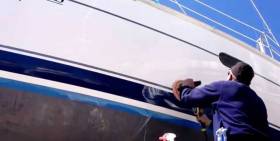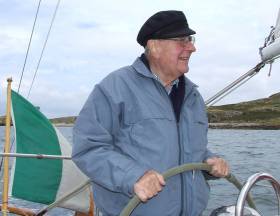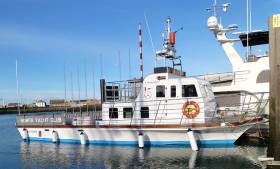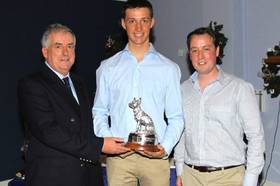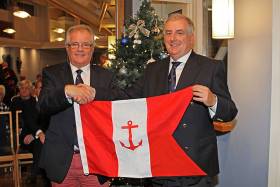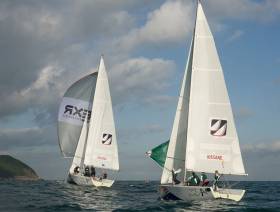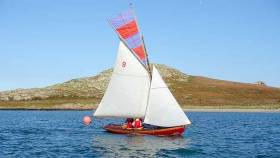Displaying items by tag: Howth Yacht Club
The RS Feva class is seeking to repeat its great turnout of 38 boats at the 2016 Greystones Sailing Club hosted National Championships. 'There is no reason why we can’t achieve similar numbers at our events this year', according to upbeat class officers.
The opening Feva event at Howth Yacht Club in April will also have the RS200, RS400, SB20 and National 18 fleets taking part.
2017 Irish RS Feva Events Calendar
April 22,23 Easterns Howth YC
May 13,14 Northerns RNIYC
July 1,2 Southerns RCYC (as part of Dinghyfest)
July 14,15,16 Nationals RStGYC
July 21-27 Worlds Holland
Aug 12,13 Inlands Blessington SC
Howth Yacht Club Offers Boatyard Services: Yacht Polishing, Boat Wash-Down, Checks & Scrubbing
Howth Yacht Club in north Dublin is now offering boatyard services at competitive rates.
The new services offered include yacht polishing, boat wash-down, boat check and an unattended scrub.
According to a note on the club website prices advertised are intended to compare closely with private direct labour charges but are now offered through HYC by 'fully insured employees'.
Based on a 10m boat costs for a full restoration polish, including materials is €300.00. A wax coat is €150.00. A Crane lift & cradle €100.25
The cost to collect the boat and return to berth is €40.00
Other services to HYC members are detailed here.
Dr Otto Glaser 1926 – 2017
Otto Glaser of Howth Yacht Club, who has died at the age of 90, had been closely and personally affected by much of the trauma engulfing 20th Century Europe. Yet he emerged as the embodiment of a civilised, cultured and highly intelligent Irishman and European, a remarkable innovator, an achiever and creator of major enterprises, and someone who was in the forefront of the economic re-birth of Ireland from the late 1950s onwards.
He was also in the forefront of Ireland’s development as a significant force in international offshore racing in the late 1960s and 1970s. Although not a cradle sailor, he brought to his new interest an intellect and energy which he found fulfilled by the challenges and technicalities of sailing and of yacht design, and it was equally fulfilling for those who sailed with him as shipmates on his variety of interesting boats.
For unlike some who might take up sailing with all the zeal of the convert on the cusp of middle age, and then move on to other activities after only a few years, he retained and fulfilled his close interest in boats and sailing and sailing people until the end of his long and extraordinary life.
Born in Vienna into a family at the heart of metropolitan life in a society which was still imbued with the reasonable and liberal values of the old Austro-Hungarian Empire, his father – also Otto – was a Austrian government minister of Jewish descent, while his mother Anna was a devout Catholic.
The Hitler-led Anschluss or annexation of Austria while young Otto was still only 11 in March 1938 saw the rapid destruction of the way of life of leading families like the Glasers. By September 1938, aged just 12, he was cut off from his family by being sent for his safety with a group of other children in what may have been the last “Children’s Train” out of Vienna in a renowned humanitarian rescue mission which took him right across Europe and England, until he found safe haven with the Holy Ghost Fathers in Blackrock College in Dublin. There, his notable intellect was soon being appreciated by the teachers trying to instill some elements of culture and learning in pupils for whom the main interest in life was rugby.
What might have become of him had he been kept in Vienna scarcely bears thinking about. His father was eventually traced by the German authorities and sent to Dachau, but miraculously survived World War II of 1939-45, while his mother likewise survived through the kindness of friends and a religious network. But in Blackrock young Otto had only his aptitude as a student and a circle of friends from a completely different background to keep him going.
And he was by no means safe, for once a year the German Embassy requested a meeting “with the German boy Otto Glaser”, ostensibly to check his welfare. But the Blackrock College authorities were under no illusion that if they let him anywhere near the German Embassy they probably would never see him again, so they devised the system whereby an official appointment would be made for a representative of the Embassy to call at the college. But lo and behold, owing to some clerical error, every year on the very day when the Embassy man called, Otto Glaser would be absent for a week at the College Retreat House in Bray, and it was against all rules to take boys out of their assigned period in Retreat.
However, young Otto had his own yearly assertions of individuality when he had to report to Dublin Castle to have his visa renewed. Each year, the normally strict official would welcome him into the office and make the routine enquiries, and when he demanded of the boy what nationality he was, the answer was always the same clear and crisp: “Austrian”. And thus “Austrian” would be patiently renewed in the documentation without comment for all that, at the time, Austria no longer officially existed.
By the time Europe was emerging from the total horror of World War II in 1945, Otto Glaser’s days at Blackrock College were drawing to a close, and he won a place at University College Dublin where he took a science degree – eventually an MSc – in physics and chemistry. Amongst the College friends against whom he enjoyed sharpening his intellect was future Taoiseach Garrett FiztGerald, and one of his main leisure interests was the UCD Literary & Historical Society, aka the Debating Society.
Eventually he became its Honorary Secretary, but as he was to disarmingly reveal later in life, that was to secure access to the telephone numbers of the more attractive and interesting female members of the Society, particularly one Patricia Delamer. Once he’d made his mind up, Otto’s mind stayed made up, and in time he married Pat Delamer and they’d been married more than six decades by the time of his sudden but peaceful death last Friday.
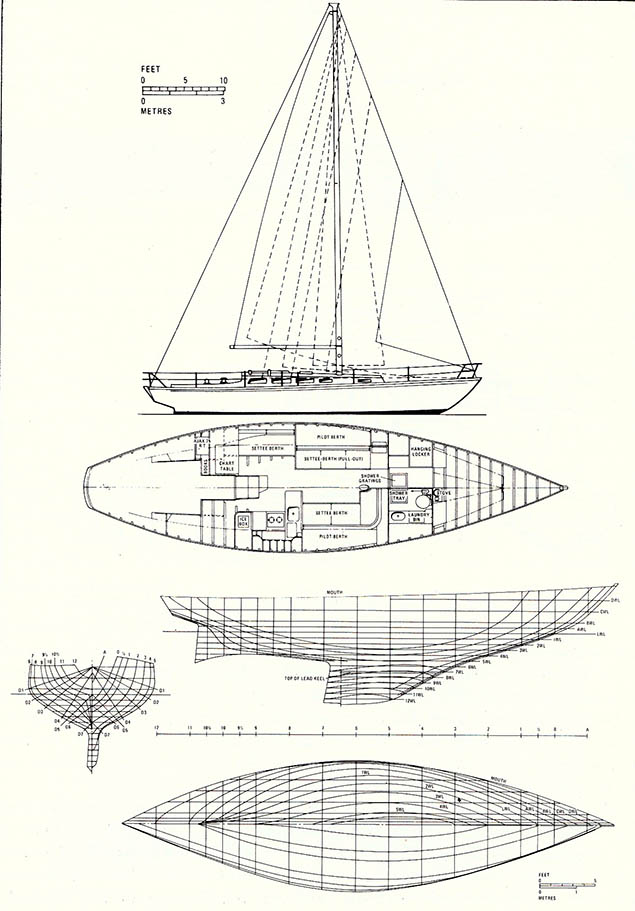 The first boat purpose-designed and built for Otto Glaser by George McGruer in Scotland was Tritsch-Tratsch I in 1971. Some of her hull ideas were developed from the 12 Metre Class racing in that period for the America’s Cup
The first boat purpose-designed and built for Otto Glaser by George McGruer in Scotland was Tritsch-Tratsch I in 1971. Some of her hull ideas were developed from the 12 Metre Class racing in that period for the America’s Cup
With Europe returning to some sort of normality after 1945, Austria re-emerged as an independent nation, and after he’d graduated with MSc at UCD, it was a source of special satisfaction to Otto that he was able to take his doctorate in Atomic Physics in Vienna, where his parents were re-building their lives. But although he always retained the strongest links with the land of his birth, Ireland was now his home, such that in the 1970s his parents joined him. And within Ireland, the Howth peninsula had become the focus of his home life after Pat’s brother Peter married Ida Lacey of a long-established Howth family.
The notion of living in Howth and building a technological manufacturing company in Ireland soon became the core of Otto’s lifeview, and though he initially brought his energy and intellect as an employee to other companies and institution such as Posts & Telegraphs, by the mid 1950s he was running his own scientific manufacturing research company Technico, and in the early 1960s that developed the Telectron company, the true pioneer of the electronics industry in Ireland.
By the late 1970s and early ’80s, Otto and his team had built Telectron into a giant by Irish standards, as it employed 800 people. And thanks to the fact that it produced small-volume high-value products, it gave him special pleasure that he could locate environmentally-friendly and compact production units in places like the Aran Islands or Gweedore in Donegal, where the sudden influx of fresh income from this totally new source made a very significant difference to the local economy.
Keeping such a show on the road required prodigious energy, but Otto had it in spades. Indeed, while busy building one of Ireland’s key companies, he somehow also found the time to be a director of Coras Trachtala - the Irish Export Board – he was also a founding board member at Dublin City University, a member of the Institute for Advanced Studies, a board member at the School for Cosmic Sciences, and one of the earliest and most active members of the European Institute in Dublin, while also being a very effective President of the Irish Austrian Society.
All this, you might think, would be enough for ten men let alone one, but in the 1960s, having settled in Howth in the house where he and Pat lived for the rest of his life and joyously re-named Thalassa, Otto Glaser had come to sailing, and an entire new area of interest and achievement was opened.
It was initially through family links, and it was called the GOLD syndicate, being Glaser, O’Reilly (Barry), Lacey (Billy) and Delamer (Peter). There was quite a busy little Dragon class in Howth at the time, so they bought themselves a vintage Dragon to see how it might all work out. But this wasn’t any old Dragon – this was Ceres, with which Eric Strain of Royal North of Ireland YC had won the Dragon Gold Cup in 1947 on the Clyde when both the Clyde and the Gold Cup were at the height of their prestige. By the 1960s, Ceres was showing her age a bit, but nothing daunted, the syndicate sailed her home to Howth from Belfast Lough, for that was what you did with a Dragon in those days.
And being as tough as old boots (he was almost immune to cold), Otto was soon hooked on sailing, so much so that within a very few years he’d persuaded the GOLD syndicate to move up to the International 8 Metre Cruiser/Racer Debbie, a lovely varnished McGruer creation from Scotland, which brought a bit of real class in a boat type which was already familiar to Howth sailors.
But for Otto Glaser, Debbie was the introduction to more – much more. With this boat, he began offshore racing, in which he found a new and particular passion in navigation. And she also introduced him to the intricacies of the of the various measurement rules, a happy hunting ground for someone with his genius-level mathematical bent.
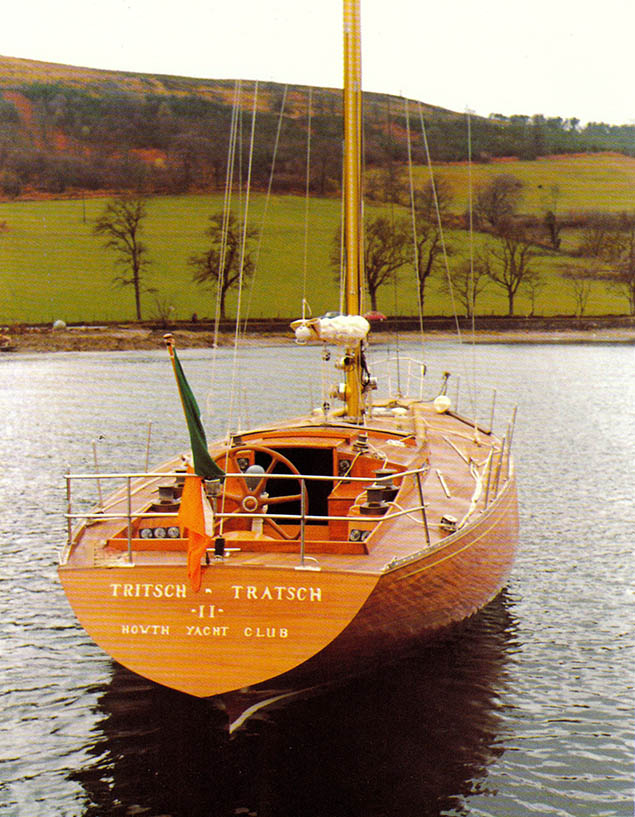 Woodenboat perfection. The new Tritsch-Tratsch II shortly after launching in March 1973
Woodenboat perfection. The new Tritsch-Tratsch II shortly after launching in March 1973
On top of that, with his Viennese sensibilities setting his tastes, he found Debbie’s exquisitely varnished hull a thing of special beauty, while in George McGruer of Clynder on the shores of the Gareloch in Scotland, he found an innovative designer and boatbuilder with whom he could work in creating potentially world-beating offshore racers which were to be built in exquisite style like the highest-quality wood furniture, and varnished throughout, inside and out.
Yet Howth by this time meant so much to him that he was determined to base his future racing boats there, and to crew them as much as possible with fellow Howth sailors, some of whom were former members of the now defunct GOLD syndicate which had been amicably wound up after its most energetic member launched himself on a ten year career through the 1970s as sole owner of three notable offshore racers.
The first result of the Glaser-McGruer combination came in 1971 with the 43ft Tritsch-Tratsch, her name emerging because there was so much talk in conceiving her and bringing her to completion that tritsch-tratsch – the Viennese dialect for “chit-chat’ – was the only name that would do. That first Tritsch-Tratsch was in some ways an evolution of the 12 Metre designs which were emerging in the America’s Cup at the time, and though her steering was augmented by a trim tab, her tiny rudder could make her a wayward thing off the wind.
But she was unbeatable to windward, and she loved a breeze of wind, for by today’s standards, she was under-canvassed. The story is told that she was once slugging to windward in a Force 7 to 8 in an RORC Irish Sea Race, and a ship passing nearby altered course to keep company. Suddenly suspecting that the ship’s crew might think there were in trouble, Howthman Pat Moore – one of the many special people whose unseen talents were encouraged by Otto in both sailing and business – called on the VHF to tell the ship they were okay. To which came the reply:
“We can see that. It’s just that your boat looks so marvellous the great way she’s sailing, we thought we’d take a little diversion to enjoy the view for a while”.
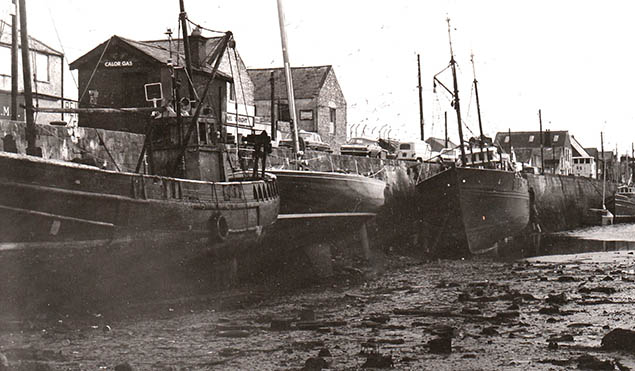 Otto Glaser always remained intensely loyal to Howth, even when facilities were so limited that Tritsch-Tritsch had to dry out against the fishing boat pier in order to have a scrub
Otto Glaser always remained intensely loyal to Howth, even when facilities were so limited that Tritsch-Tritsch had to dry out against the fishing boat pier in order to have a scrub
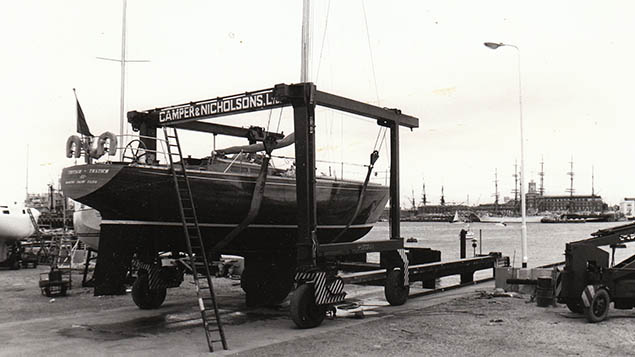 Facilities undreamt of in Ireland at the time – Tritsch-Tratsch II in Camper & Nicholson’s travelhoist in Gosport in 1973
Facilities undreamt of in Ireland at the time – Tritsch-Tratsch II in Camper & Nicholson’s travelhoist in Gosport in 1973
But while the first Tritsch-Tratsch was a success and the highest-scoring boat in the 1971 Irish Admiral’s Cup team, taking part in that then-supreme series gave Otto another line of interest, and for 1973 he ordered a very different sort of Tritsch Tratsch with the Admiral’s Cup again in mind. By this time the International Offshore Rule was well set in place, and trim tabs and the like were penalized out of existence, so he and George McGruer plotted another varnished beauty, the very different Tritsch-Tratsch II, 47ft long and designed to be as good off the wind as on it.
Yet although she became the first Irish boat to win an RORC race overall in the English Channel overall, T-T II always seemed to be on the brink of some greater achievement, yet never quite made it. But she was a fantastic well-mannered boat to sail, a joy to be aboard with the most beautiful teak construction much in evidence. And she brought Otto much pleasure, for those of us who sailed with him at the time can remember him arriving aboard with only hours to go to the start of the next RORC Race, and he’d be utterly grey with exhaustion after some world-girdling business trip. Yet after an hour or so of power-napping, he’d be right as rain and ready to keep awake all night as he worked the then-much-greater mysteries of the navigator and tactician’s art.
 Tritsch-Tratsch II was designed to be as good off the wind as on it, and she was very well-mannered with it. In 1974 she was the first Irish boat ever to win an RORC race overall in the English Channel.There were successes, but as the seasons of 1973 and ’74 progressed, other boats continued to improve in their speeds, yet Tritsch-Tratsch seemed to have hit some sort of ceiling on her performance. Nevertheless she had her moments, and a noted achievement was in a harsh RORC Cowes to Cork windward race in 1974, when Otto called the tack in a very slowly backing wind south of Land’s End to such perfection that we remained hard on the wind all the way to the finish at the old Daunt Lightvessel 155 miles away off Cork Harbour, and hadn’t raced one unnecessary foot by the time we got there, with all the hot Cork boats a long way astern.
Tritsch-Tratsch II was designed to be as good off the wind as on it, and she was very well-mannered with it. In 1974 she was the first Irish boat ever to win an RORC race overall in the English Channel.There were successes, but as the seasons of 1973 and ’74 progressed, other boats continued to improve in their speeds, yet Tritsch-Tratsch seemed to have hit some sort of ceiling on her performance. Nevertheless she had her moments, and a noted achievement was in a harsh RORC Cowes to Cork windward race in 1974, when Otto called the tack in a very slowly backing wind south of Land’s End to such perfection that we remained hard on the wind all the way to the finish at the old Daunt Lightvessel 155 miles away off Cork Harbour, and hadn’t raced one unnecessary foot by the time we got there, with all the hot Cork boats a long way astern.
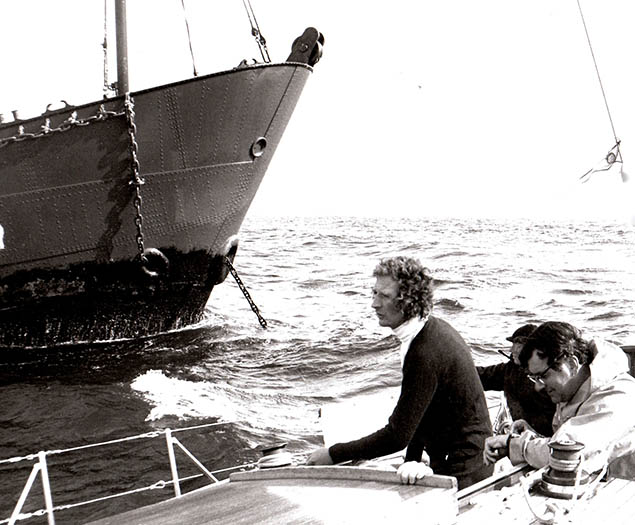 Pat Moore with Otto Glaser recording the time as Tritsch-Tratsch II passes the Daunt Lightvessel off Cork Harbour to finish a textbook RORC Cowes-Cork Race in 1974. Photo: W M Nixon
Pat Moore with Otto Glaser recording the time as Tritsch-Tratsch II passes the Daunt Lightvessel off Cork Harbour to finish a textbook RORC Cowes-Cork Race in 1974. Photo: W M Nixon
Despite this experience of featuring in the frame, T-T II was increasingly relatively weak in light breezes, so Otto and George spent much of 1975 tinkering with a taller mast and re-trimming of the boat to an almost absurd degree to lower the rating, but there was no way she was going to make it onto the Irish Admirals Cup team. The Fastnet Race provided considerable consolation in that he beat all the Irish AC team in the overall scoreline, but he decided that T-T II had had her day, and she was sold to Sweden.
But although work was taking up even more of his time, Otto decided to re-join the fray for 1977 with a nearly-new Frers 47, Red Rock, which just happened to be in Argentina. For Dr Glaser, such logistics problems were simply there to be overcome, so he arranged to have her shipped to Europe immediately.
However, as Red Rock in her cradle proceeded up the Atlantic on the decks of a ship, a dock strike at her destination threatened to derail her entire planned season. Again, no problem. Otto got on the radio to the ship’s captain and – I’m not making this up – he persuaded him to divert his ship through the Solent, and further persuaded him to activate his little-used derricks and lower the unmanned Red Rock III, complete with cradle and all, into the waters off Cowes where she was met by Groves and Guttridge’s launch and towed, admittedly with some difficulty, into Cowes where the entire caboodle was lifted out and Red Rock was prepared for a season’s racing.
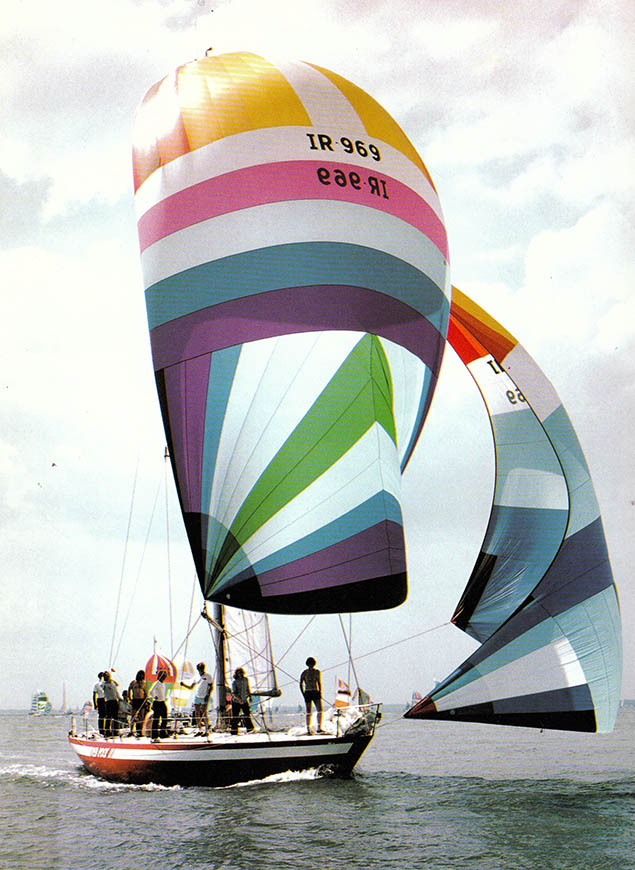 Laid back style….a mostly Howth crew racing Red Rock in 1977 in the Solent, where only a couple of months earlier she had been unloaded directly into the water from the ship which brought her from Buenos Aires, as a dock strike precluded the use of a port.
Laid back style….a mostly Howth crew racing Red Rock in 1977 in the Solent, where only a couple of months earlier she had been unloaded directly into the water from the ship which brought her from Buenos Aires, as a dock strike precluded the use of a port.
Alas, it did not include gaining selection for the Irish Admirals Cup Team, but it did include getting into the very sharp end of the finishing score of the Fastnet Race fleet, so the whole crazy season was dubbed a success. And it was done despite the increasing demands of business, for by this time the top end of the electronics industry was getting to be a very warlike place.
By Irish standards, Telectron going into the 1980s was an impressive company – the R & D budget alone was more £1 million. But Alcatel was muscling in with an R & D budget ten times greater, so some sort of re-structuring of the industry between the two companies made sense, and Otto Glaser finally eased back on his workload and returned to his roots with Technico.
But far from seeing a slowdown in his pace of life, he kept it up, but changed the emphasis. His work with the Irish Austrian Society and the European Institute and many other bodies increased, so much so that the Austrian Government awarded him its Honour in Gold for Service to the Republic of Austria. And while his offshore racing career may have been completed, he took up cruising with considerable energy, buying the 1973-built 59ft Jongkert steel ketch Verna and cruising her to South America down to Rio, and then back north through the Caribbean with such style that he was awarded the Irish Cruising Club’s premier trophy, the Faulkner Cup, for 1984, his log being titled in typically impish Otto style: “My First Cruise”
 The 1973-built 59ft ketch Verna, with which Otto Glaser cruised to Rio de Janeiro to be awarded the Irish Cruising Club’s Faulkner Cup for 1984.
The 1973-built 59ft ketch Verna, with which Otto Glaser cruised to Rio de Janeiro to be awarded the Irish Cruising Club’s Faulkner Cup for 1984.
However, even for cruising he needed a bit of a challenge in the boat creation area, yet he also relished sailing in home waters, so with the resources released by the company’s re-structuring, he bought an F & C 44 ketch, the distinctive dark red German Frers Senr-designed Tritsch Tratsch IV, which he kept in Howth, and then to spread his wings he took on a five year challenge of owning and running a hefty Frers-designed Hylas 60 sloop, which cruised the length and breadth of the Mediterranean with particular emphasis on the old coastlines of the former Austro-Hungarian Empire in the Adriatic which he had known as a child.
This big boat with her enormous mast, simply called Tritsch-Tratsch, could be quite a difficult one in some smaller places, but Otto still had some long-cherished ambitions, and one was to berth his vessel right at the Cipriani Hotel in Venice. This was somehow managed with about an inch to spare under the keel, and a couple of inches fore and aft.
Yet he kept a fond eye on his former boats where possible, and when the American owner of the original McGruer-designed T-T I invited him to use the boat for a Cruise-in-Company in Maine and Nova Scotia, he rustled together a ship’s company of former racing mates, and they had themselves a fine old time.
But as the years went by, increasingly his sailing experience became focused on the ketch Tritsch-Tratsch IV in Howth, and as the years advanced with Otto well into his eighties, the programme narrowed down to regular outings for two or three hours every Sunday morning, with the emphasis on winter sailing, which was much to Otto’s taste as he remained immune to the cold.
Thanks to T-T I’s very manageable ketch rig, the mainsail was seldom set, so much so that it’s said that when an energetic nephew persuaded him they should have all three sails up and drawings, the remains of a bird’s nest fell out of the mainsail as it was being hoisted. But usually under mizzen and genoa, this sweet classic made along in a very satisfying way, and the crack was always mighty.
It was a sort of secret society in which the only rule was that if you wished to go, you had to be on board by 1100 hrs sharp, for they waited for no-one. As to who you might find on board, it could be anyone – I remember once being serenaded on our way northwards towards Lambay by the Austrian ambassador, who could have made a reasonable living in provincial opera had he been so inclined.
Then at other times, there’d be quiet talk about those who were gone, and the past generally. I’d long since been aware that a particular sadness attached to Tritsch-Tratstch II, for it was only as Otto was about to part company with her that it was discovered that one of the small but very important markers in the hull for the IOR measuring station was a foot out of place. In the haste to get her ready for that first season of 1973, a crucial error had been made in installing it which meant that, no matter what way you trimmed and re-rated her, she always rated significantly higher than she should have.
Yet she was such a superb boat, a real beauty, that the rumour was that eventually she was bought by a drug smuggler who reckoned that such a beauty would be the perfect camouflage for his activities in the Eastern Mediterranean. But in due course, so it was said, the powers-that-be rumbled him, and the most lovely McGruer boat had been arrested and impounded in some anonymous waterfront government yard.
On one of our Sunday morning sails, Otto and I found ourselves on our own in the cockpit, the ships’ company being busy below with creating hot whiskeys on an industrial scale, so I asked if the story of the fate of Tritsch-Tratsch II was true.
He gazed towards the horizon for a few seconds, then quietly answered: “It’s true. She’s dusty and gone, locked in the customs compound in Smyrna”.
The essence of Otto Glaser was in that reply. He had kept the sadness to himself, as he kept many other much greater personal sadnesses. But he was always sustained by a very special inner strength. Yet when he did reveal himself, it was in all his civilised European complexity and style. For Smyrna of ancient Greece has been Izmir in Turkey since 1922. But for someone with Otto’s classical background and long view of European history, it was still Smyrna, and now for him it always will be. We will miss this very special man very much indeed, and our heartfelt sympathies are with his family.
WMN
Howth Yacht Club's Volunteers Step Up To The Plate
It takes between 60 and 70 dedicated special voluntary workers to keep a multi-functional organisation like Howth Yacht Club running smoothly with a friendly atmosphere around the place writes W M Nixon.
That number is in addition to the elected officers and committee with its sub-committees, plus the professional staff. The figure was reached when incoming Commodore Joe McPeake set in train a project to ensure that the key posts are filled, and to let the many voluntary workers who are the lifeblood of the club know that their efforts are appreciated.
As part of this, last night (Thursday) the Commodore hosted a very informal Volunteers’ Evening when the different sub-committees and task forces were able to set up their stalls – or more accurately, their tables - and see what they could do in the way of recruiting new blood from amongst the people gently milling past, people keen to help and get more deeply involved with a club that means a lot to them, but are not quite sure how to start going about it.
In some ways it was reminiscent of a very low key Freshers’ Week event at college. But we hasten to emphasise the “low key”. The ideal volunteer is not flamboyant. On the contrary, they’re quiet folk with hidden capabilities which can be revealed over time, people who, when they commit to something, really mean it - they can be relied on to make a useful input when contacted, they will get on with the job without fuss, and often it’s found that they’ve also been quietly getting on with some other personal project which will be of real benefit to the club and their fellow members.
In fact, the atmosphere last night was so pleasant it was suggested they should hold a Volunteers’ Night every week……But already the standards have been set very high. HYC’s main Committee Boat Star Point is not exactly the most elegant vessel afloat. However, longtime Committee Boat crewman John Doran and a small task force found this specialist sports fishing platform competitively for sale in Wales a couple of years ago, and identified her as a vessel which would, with manageable modifications, be ideal as a Committee Boat.
Such has indeed proven to be the case. But Star Point is a soncey big beast. She’s at the limit for what can be lifted in one of Howth YC’s own cranes. So when a major refit was planned at mid-winter between the two halves of the long-running HYC Brass Monkey series (it’s celebrating its 30th birthday), Star Point had to go to the boatyard at Malahide, and the professional refit quotes were scary.
Nothing daunted, former HYC Commodore and leading race officer Derek Bothwell already had a voluntary work party being recruited, and as much as possible of the work – a very impressive part of it, actually – was done entirely by voluntary effort during the coldest week of the year, “when the boat seemed to get bigger by the minute”.
Although one of the good points about Star Point when she was bought was the fact that she was already Copper-Coated beneath the waterline, even that very effective longterm anti-fouling will accumulate grunge over many years, and cleaning it off was brutal work. But when the spick and span re-born Star Point was brought back to Howth a week ago, John Doran was able to report that with the new clean bottom and a good blow-out for the engines, he could get her up to 17.5 knots where previously the best speed was a measly 12 knots.
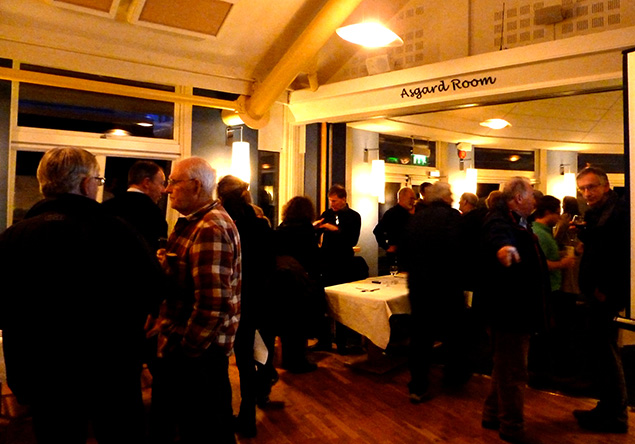
Howth Yacht Club Seeks Volunteers for 2017 Season
Howth Yacht Club is hosting a 'Volunteer Night' on Thursday (26th January). The north Dublin club, one of the biggest sailing clubs in the country, is seeking support from members and asking them to consider helping with a variety of tasks including upkeep of the J80 keelboat fleet. The volunteer night will feature roles in HYC's Autumn League, Lambay Regatta, Junior Sailing, Communications and Membership offices.
HYC is also hoping to find crane drivers, launch drivers plus a range of communications officers to help with content writing and photography for the club website. The club also hopes to find an archivist for its 125th Anniversary.
Howth Yacht Club Seeks Sailing Development Officer
#HYC - Howth Yacht Club is recruiting for the role of Sailing Development Officer.
The successful applicant will help create and implement a programme that will increase participation in sailing and other marine activities, devise marketing initiatives to promote/fund the sport of sailing, and increase club membership.
The skills required for this role include a passion for sport and an ability to devise and implement programmes to specific objectives which will be set by the successful applicant in conjunction with the club co-ordinator.
Applicants must have a proven ability to plan and successfully implement such programmes, and previous involvement in this type of role would be a positive attribute.
It should be noted that the club already provides sailing courses for all ages, including a world-class youth performance programme, all of which will be reviewed and enhanced.
The club also wishes to target new activities and markets, including large corporate organisations that wish to be linked with a facility that can provide an attractive and enjoyable lifestyle for their employees.
Applicants should have the skills to be innovative and self-motivated to achieve the set objectives, and should also have strong communicative and IT skills.
The Sailing Development Officer will report to the Commodore of Howth Yacht Club or another nominated officer. It would be expected that the successful applicant will report on a defined basis every two weeks to the nominated officer. Renumeration will be negotiated with the successful applicant and will be performance-related.
Applications should be sent by email to [email protected] or by post to:
The Commodore,
Howth Yacht Club CLG,
Middle Pier,
Howth Harbour,
Howth,
Dublin D13 E6V3
Howth Yacht Club Salutes Ewan McMahon's Laser Radial World Silver Medal
Talented Howth Yacht Club sailor Ewan McMahon received his club's top award at an Achievers Ceremong in the North Dublin Club last weekend. McMahon (17) won silver at the KBC Laser Radial Youth World Championships in Dun Laoghaire, in a fine display of consistent sailing across the wind range on Dublin Bay.
Read more about his performance in today's Irish Times Sailing Column here and from Howth Yacht Club here.
Howth Yacht Club Elects New Commodore
The 121-year-old Howth Yacht Club, which has one of the largest yacht or sailing club memberships in the country, saw Joe McPeake succeed Berchmans Gannon unopposed as Commodore at a very well-attended Annual General Meeting in the club on Thursday December 8th writes W M Nixon.
What may well be a record AGM turnout of 275 voting members gave strong support to the new management team, which retains former officers Emmet Dalton as Vice Commodore, Ian Byrne and Jonathan Wormald as Rear Commodores, and Bernadette Condy as Honorary Secretary, while the new Honorary Treasurer is David Mulligan. He is an experienced financial administrator while also being a sailor’s sailor who actively campaigned a classic Howth 17 and then an Etchells 22, following which he has been a stalwart as an owner-skipper in the white-sail cruiser class.
New Commodore Joe McPeake – who was formerly Rear Commodore – is a lawyer and property developer who has been an HYC member for 26 years, and is a boat owner who has recently concentrated on cruising under both power and sail, his ventures including reaching the Arctic Circle along the Norwegian coast in a Contest ketch. But he has also raced locally, and in national regatta weeks, as well as racing round Ireland.
A strong committee moves into place combining much new talent with many experienced long time voluntary workers for sailing and HYC. While - like many clubs - Howth has gone through difficulties during the lean years, the meeting concluded in an optimistic mood, as the good news included the fact that a much-needed roof replacement project has come in on time and within budget.
 Some of the record fleet in the current Brass Monkeys series at Howth competing their final race of the first half on Sunday, with an HYC-owned J/80 foreground .
Some of the record fleet in the current Brass Monkeys series at Howth competing their final race of the first half on Sunday, with an HYC-owned J/80 foreground .
As though to emphasise the spirit of can-do optimism which became the HYC mood around mid-meeting, next day saw the annual and decidedly convivial charity lunch organized by top offshore skipper Dave Cullen. It featured a presentation by Marcus Hutchinson (originally of Howth) about the Vendee Globe and Enda O’Coineen’s participation in it, including a live interview with the gallant man himself deep into the Southern Ocean, while the event raised €27,000 for Children’s Liver Disease Research.
Then next day the annual HYC Brass Monkeys Winter League – now approaching its 30th year of organisation by Pat Connolly – concluded its first half with a record fleet racing including J/80s from HYC’s own training fleet.
Following that, the noted toy distributor S Claus of North Pole Enterprises came to call on Sunday (yesterday), and then this Thursday (December 15th) sees perhaps the most legendary annual event in the HYC social calendar, the Ladies Lunch organised by Martina Gannon and her team, this year in support of The Ross Nugent Foundation. Guest speaker this year is Howth’s own Susan Whelan, who is CEO of Premiership champions Leicester City Football Club. Needless to say, the event has long been a sell-out.
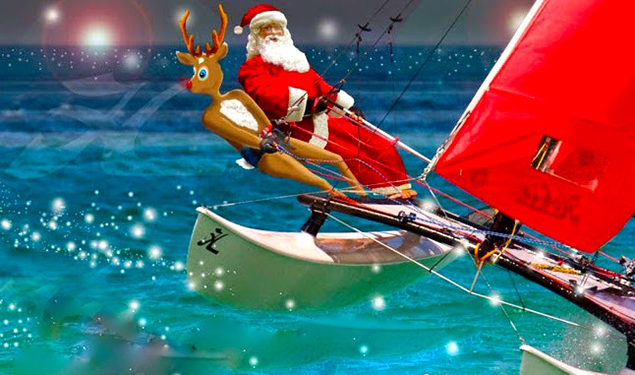 Coming to a club near you – the noted Toy Distributor S Claus of North Pole Enterprises has been using some novel ways of going about his business this year
Coming to a club near you – the noted Toy Distributor S Claus of North Pole Enterprises has been using some novel ways of going about his business this year
Howth Yacht Club's Kissane Lying 15th Overall in Women's Match Racing After Busan Cup
Howth Yacht Club's Diana Kissane, Jane Butler, Clara Hynes, Tara Flood and Jennifer Andreasson were tenth overall at the Busan Cup Women's International Match Race at the weekend. As Afloat.ie reported previously it means the sole Irish competitors in the Womens International Series now lie 15th from 25 after four events out of five sailed.
As one of the most experienced match racing skippers in the world, Australian Katie Spithill has been to every Busan Cup Women's International Match Race since the inaugural event in 2008, except for the single year she had her daughter. But not until Saturday the 29th of October 2016 did she go all the way through to winning in Korea; over previous two-time
In Korea, the waters just outside the beautiful Haeundae Beach of Korean city Busan offered the most challenging of sailing conditions, as the Busan Cup Women's International Match Race came down the wire with semi finals and final Saturday. In incredibly shifty, puffy and gusty winds, Spithill won her semi 3 - 1 over round-robin winner Claire Leroy.
Previous double World Champion and 2007 World Sailor of the Year, Claire Leroy, defeated Ostling 2 – 0 to take the petite final
Results in the Busan Cup Women's International Match Race, the 4th and penultimate event of the 2016 WIM Series are below:
1. Katie Spithill, Alessandra Angelini, Jessica Eastwell, Kate Lathouras and Stacey Jackson, AUS, 25 points
2. Lucy Macgregor, Annie Lush, Mariana Lobato, Elodie Mettraux and Mary Rook, GBR, 22
3. Claire Leroy, Marie Riou, Claire Pruvot, Julie Gerecht and Morgane Gautier, FRA, 20
4. Anna Ostling, Hanna Klinga, Linnea Wennergren, Marie Berg and Annika Carlunger, SWE, 18
5. Trine Palludan, Lea Richter Vogelius, Josefine Boel Rasmussen, Laerke Ilso Norgaard and Joan Vestergaard Hansen, DEN, 16
6. Stephanie Roble, Maggie Shea, Aimee Famularo, Elizabeth Shaw and Janel Zarkowsky, USA, 14
7. Pauline Courtois, Maelenn Lemaitre, Berenice Delpuech, Sophonie Affagard and Juliette Le Friec, FRA, 12
8. Caroline Sylvan, Malin Holmberg, Anna Norlander, Frida Langenius and My Karlsten Sfiris, SWE, 10
9. Renee Groeneveld, Annemieke Bes, Lobke Berkhout, Claire Blom and Marcelien de Koning, NED, 8
10. Diana Kissane, Jane Butler, Clara Hynes, Tara Flood and Jennifer Andreasson, IRL, 7
11. Milly Bennett, Alice Tarnawski, Rosie Lee, Stephanie Doyle, Carrington Brady and Tara Blanc-Ramos, AUS, 6
12. Gyeong Jin Lee, Ji A Kim, Min Ju Kim, Da Eun Yang and Da Som Park, KOR, 5
Results in the final:
Katie Spithill, AUS - Lucy Macgregor, GBR, 3 - 2
Results in the petite final:
Anna Ostling, SWE - Claire Leroy, FRA, 0 - 2
Semi final results:
Katie Spithill, AUS - Claire Leroy, FRA, 3 - 1
Anna Ostling, SWE - Lucy Macgregor, GBR, 0 - 3
Standings in the 2016 WIM Series after four events out of five (skipper, country, WIM Series points):
1. Anna Ostling, SWE, 93
2. Pauline Courtois, FRA, 60
3. Caroline Sylvan, SWE, 58
4. Stephanie Roble, USA, 54
5. Camilla Ulrikkeholm Klinkby, DEN, 54
6. Renee Groeneveld, NED, 49
7. Katie Spithill, AUS, 25
8. Lucy Macgregor, GBR, 22
9. Anne-Claire Le Berre, FRA, 22
10. Marinella Laaksonen, FIN, 21
11. Claire Leroy, FRA, 20
12. Lotte Meldgaard, DEN, 18
13. Samantha Norman, NZL, 14
14. Sanna Hager, SWE, 14
15. Diana Kissane, IRL, 14
16. Alexa Bezel, SUI, 12
17. Rikst Dijkstra, NED, 12
18. Nicole Breault, USA, 10
19. Johanna Bergqvist, SWE, 10
20. Antonia Degerlund, FIN, 10
21. Elizabeth Shaw, CAN, 8
22. Susanna Kukkonen FIN, 8
23. Milly Bennett, AUS, 6
24. Gyeong Jin Lee, KOR, 5
25. Sanna Mattsson, SWE, 5
In an event and at a time of the year that always promises to challenge the skills of keelboat sailors, the 37th consecutive year of Howth Yacht Club’s Autumn League didn’t disappoint the hundreds of competitors who entered and completed the six-week series this weekend. Losing two of the race days due to the contrasting weather conditions that are to be expected in September and October in these latitudes, only demonstrated that those who emerged as winners in the eight competing classes (and 15 divisions) could rightfully boast about having the ability to succeed in a variety of weather conditions, sea states and in a mix of ‘round the cans’ and ‘windward-leeward’ race courses.
The final day gave the competitors a light breeze of 10-12 knots from the southeast, increasing steadily over the 90 to 120 minutes that they would take to complete their last race of the series. The race management team cleverly utilised the race schedule to ensure that the event would be completed having given the competing teams 5 races, including two windward-leeward on one of the days – this despite having to cancel two race days as mentioned above.
HYC’s Commodore Berchmans Gannon praised the race management teams for their skillful work and relayed the thanks of the 600 competing sailors. He also thanked event sponsors MSL Park Motors Mercedes-Benz for the huge added value that they were able to bring to the event, observing how they have become an integral partner to the club and their support is greatly appreciated by the members, guests, event competitors and visitors.
The final prizegiving is always a lengthy affair and this year’s presentations were no exception with over 40 different prizes awarded, including presentations to the ‘Team Event’ winners – Howth 17 ‘Aura’, Puppeteer ‘Gold Dust’ and the Half Tonner ‘Harmony’. David Cullen’s ‘Checkmate’ won the overall event and Heineken Trophy and the trophy was presented to crew Aidan Beggan.
A special presentation was made to Howth RNLI and Rupert Jeffares by event sponsors Brendan Grace and Dean Fullston from MSL Park Motors Mercedes-Benz, with a cheque for €1000.
Competitors and their guests enjoyed the post event celebrations at the event dinner in HYC and in the very many local restaurants that were booked out everywhere in the village and then returned back to the club for the live entertainment and late DJ.
The other winners:
IRC
Class 1 Storm (Pat Kelly)
Class 2 Checkmate XV (Cullen/ Biggs)
Class 3 Alliance II (Vincent Gaffney)
Class 4 Tiger (Harris/ Hughes)
Class 5 Demelza (Steffi Ennis/ Windsor Lauden)
ECHO
Class 1 Sourfiere (Stephen O'Flaherty)
Class 2 Kodachi (Wright/ DeNeve)
Class 3 Kahera (R Camier)
Class 4 Splashdance (Howard McMullen)
Class 5 Mary Ellen (Kevin O'Byrne)
Scratch Handicap
Puppeteers Harlequin (David Clarke/ Liam Egan) Flycatcher (Frank Dillon)
Howth 17s Isobel (Brian & Conor Turvey) Silver Moon (Susan Morgan)
Taste of Racing Leahanne McHenry



























